Madison Metro
Madison Metro Transit operates a bus service throughout the city of Madison, Wisconsin, United States and most of its immediate suburbs, including the Town of Madison, the City of Middleton, Fitchburg, Maple Bluff, Shorewood Hills, Sun Prairie, Verona, and a small portion of McFarland.[1] System-wide, fixed route ridership was 13,385,628 in 2018.[2] Metro Transit also provides supplemental transit services to some Madison middle and high schools. Several schools have switched to yellow buses in 2019. These routes are open to the general public, but have been designed to provide additional services during peak school times.[3] Metro also serves the University of Wisconsin–Madison campus, Eagle Heights University apartments, and some off-campus residential areas, via routes 80, 81, 82, and 84. The "80 routes" are free of charge.[4]
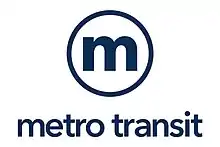 | |
| Parent | City of Madison |
|---|---|
| Headquarters | 1245 E. Washington Ave. |
| Locale | Madison, Wisconsin |
| Service area | 72 square miles |
| Service type | Bus service, Paratransit |
| Routes | 70 |
| Stops | 2,345 bus stops |
| Destinations | Town of Madison, Fitchburg, Maple Bluff, Middleton, Shorewood Hills, Verona, McFarland, Sun Prairie |
| Hubs |
|
| Fleet | 215 fixed-route buses, 20 paratransit vehicles |
| Daily ridership | 58,700 trips |
| Fuel type | Low Sulfur diesel, Hybrid diesel-electric, and some battery-operated electric buses (active 2020) |
| Operator | City of Madison |
| Website | www |
Metro also connects with suburban mass transit services, such as the Monona Lift/Monona Express and Sun Prairie Shared Taxi Shuttle.[5]
Route network
The route network focuses on hubs at the Capitol Square in downtown Madison and four major transfer points in outer parts of Madison. Core all day routes "pulse" at the transfer points every 30 to 60 minutes and are supplemented by an overlay of commuter service. Many routes serve downtown Madison and the University of Wisconsin Madison where transit use is high.[6]
The most recent service update reflected in this article went into effect in August 2013. Significant changes include the restructuring of Routes 9 and 10, significant changes to Route 18, and the introduction of two new routes in east Madison - Routes 31 and 35, and expansion of Route 33 in east Madison. Route 85 was consolidated into Route 80 in August 2012 as a result of a UW budget shortfall.[7]
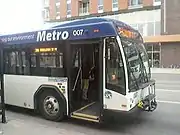
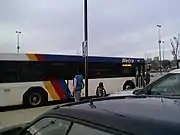
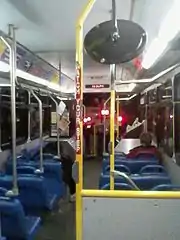
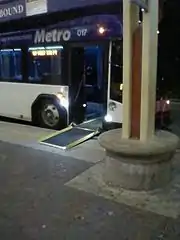
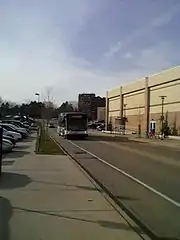
Bus fleet
- 800-875 New Flyer D40LF (Most have been retired, Main use for school service and extra buses)
- 876-999, 100-160 Gillig Advantage (several of the oldest in the fleet have been retired)
- 001-021 Gillig/GM/Allison (Gillig BRT Hybrid)[8]
- 1901-1915 New Flyer Xcelsior (40' ft) added in 2019.
- 3 Proterra, Inc. Electric Buses, joined fleet 2020- 21.
Ridership
| Ridership | Change over previous year | |
|---|---|---|
| 2013[9] | 15,001,760 | n/a |
| 2014[10] | 15,492,317 | |
| 2015[11] | 14,632,229 | |
| 2016[12] | 13,584,517 | |
| 2017[13] | 13,108,095 | |
| 2018[14] | 13,385,628 | |
| 2019[15] | 12,969,815 | |
| 2020[16] | 4,755,375 | |
Gallery
 Metro bus on State Street
Metro bus on State Street A Madison Metro bus stop sign
A Madison Metro bus stop sign The front of a Metro Gillig BRT hybrid bus
The front of a Metro Gillig BRT hybrid bus Inside a hybrid bus at night
Inside a hybrid bus at night
See also
References
- Madison Metro Transit (2018). "Madison Metro System Maps". City of Madison. Retrieved 17 January 2019.
- Staff (2018). "2018 Annual Report" (PDF). Metro Transit. City of Madison, WI. Retrieved 11 May 2020.
- "Supplemental School Service". Metro Transit - City of Madison, Wisconsin.
- "Bus Routes". wisc.edu.
- "Sun Prairie Taxi Service - Routes & Schedules". Metro Transit - City of Madison, Wisconsin. Archived from the original on 2012-09-26.
- "2013-2017 Transit Development Plan for the Madison Urban Area" (PDF), greatermadisonmpo.org
- Savidge, Nico (Mar 11, 2022). "UW announces changes to campus bus routes". madison.com.
- Staff (2010). "METRO HYBRID BUSES". Metro Transit. City of Madison, WI. Retrieved 1 July 2012.
- "2013 Metro Transit System profile" (PDF), transit.dot.gov
- "2014 Metro Transit System profile" (PDF), transit.dot.gov
- "2015 Metro Transit System profile" (PDF), transit.dot.gov
- "2016 Metro Transit System profile" (PDF), transit.dot.gov
- "2017 Metro Transit System profile" (PDF), transit.dot.gov
- "2018 Metro Transit System profile" (PDF), transit.dot.gov
- "2019 Metro Transit System profile" (PDF), transit.dot.gov
- "2020 Metro Transit System profile" (PDF), transit.dot.gov